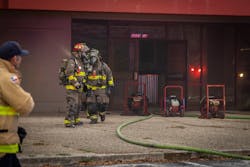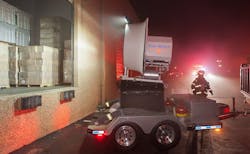Part of the overall tactical plan at a structure fire requires some form of ventilation as crews conduct primary searches and work toward fire control. This includes controlling air flow-paths while charged handlines are deployed.
The method of ventilation on commercial buildings usually comes in two main choices: vertical ventilation or positive pressure attack (PPA). (Opening man-doors or roll-up doors to use natural ventilation also is an option.)
In a fire service culture that’s steeped in tradition, it might be worth pausing and looking at the benefits of PPA from a task level and philosophical point of view.
PPA often is underutilized for numerous reasons: lack of complete understanding of its operation and of why and how it works; deficient training opportunities; and the possibility that it might necessitate a change from familiar ventilation techniques.
Both vertical ventilation and PPA have pros and cons. When choosing PPA at a commercial structure fire, you might need to think outside of the box. Firefighters also must understand fire dynamics, where the fire is located, where are possible occupants, the interior crew’s position and location of the correctly sized exhaust portal.
A fan favorite?
According to the UL Fire Safety Research Institute, PPA is “The use of a high-powered fan to control the flow of products of combustion, prior to fire control, with the intent of providing increased visibility and tenability for firefighters and potential occupants while fire suppression efforts are underway.” This differs from positive pressure ventilation, which uses a fan to remove products of combustion after the fire has been controlled.
“The advantage of PPA is that crews are not subjecting themselves to the physics of fire,” retired Salt Lake City Fire Department Battalion Chief Kriss Garcia says. “Instead, they are controlling the physics through a coordinated attack.”
The theory that’s behind PPA is that it creates a higher pressure on the interior than the pressure that’s outside of the structure. This increases the flow of heat and the products of combustion and forces them to move to the lower pressure that’s outside of the structure, ahead of firefighters who are making an attack on the fire. During the PPA process, additional oxygen is provided to the fire and can increase the rate of heat and energy that’s being released. Opinions vary on the success of this tactic, and studies are continuing to provide scientific answers about this tactic, but it’s mutually agreed that its use needs to be combined with suppression efforts.
Fans can range in size from 16 inches to 27 inches in diameter and are powered either by gasoline or electric. They can move up to 18,000 cfm of air or more when arranged together. Specialty fans that are 46 inches in diameter or larger can be found mounted on trucks or pulled on trailers and can move up to 130,000 cfm. These fans typically have a slower response time to the scene.
A fan(s) needs to be placed preferably in the opening that firefighters use for entry for fire suppression, about 4–6 feet from the opening. Sometimes in larger commercial buildings, several fans must be placed and used in a coordinated manner at multiple openings. This task utilizes door control to use only the specific opening(s) to obtain the desired effect of safely and systematically pressurizing the building’s interior.
Remember, wind will overpower PPA: PPA can’t be used to oppose natural wind, but natural ventilation can enhance PPA.
When you use fans in series, it is best to set them up so air flow from one doesn’t block the flow from another, which is why fans that are placed in a “V” shape in front of the opening are more efficient.
In some departments, gasoline-powered fans are carried only on ladder trucks, which slows the setup time. That said, it isn’t necessary for fan setup to be constrained to ladder crews; a front-line engine quickly could perform the task. Other departments might have difficulty using a fan with PPA, because they might not have the staffing to complete all of the needed tasks prior to entry, such as take a hydrant, deploy a charged handline, create an exhaust portal and set up a fan.Exhaust portal
It is imperative that an exhaust portal is two to three times larger than the size of the ventilation opening, to provide a place for the smoke and heat to vacate the structure. If this can’t be accomplished, the use of PPA might be a no-go. If the ventilation exhaust opening isn’t large enough, the pressure inside can create a back flow.
“If you don’t have an ample size exhaust opening two to three times the size of the entrance, you are turning the building into a convection oven,” Garcia states. This can cause the fire to grow in an expediential way, he says.
Effective exhaust portals, such as service doors or roll-up doors, can be located from the outside with the help of a thermal imaging camera (TIC). A hot spot that’s behind the doors could indicate a supportive location to make into an exhaust opening. It also is difficult to know in large structures whether the entrance door connects to the exhaust openings, such as roll-up doors. There might be several doors in the middle.
Advantages of PPA
To use PPA correctly requires that some tasks be performed sequentially, and the timing of those assignments needs to be coordinated, so air from the fan(s) is engaged prior to the entry of the interior crews with their charged handline. This will accomplish several things:
- Reduces interior heat levels, which increases victim survivability because of the introduction of cool and fresh air
- Decreases the rate of fire spread
- Improves firefighters’ visibility; they can safely operate in a clear atmosphere
- Reduces carbon-monoxide levels
- Reduces property damage, because smoke and soot are removed
Controversy
Ventilation using fans isn’t without conflicting opinions. Firefighters from distinctive cultures and different geographical locations might disagree on how to do what needs to be done.
“If there are 30,000 fire departments across the country, there are 30,000 ways to fight fire and ventilate it,” Stephen Kerber, who is the director of UL Fire Safety Research Institute, says.
He adds, “I have not seen PPA play out in an open geometry building. It could possibly increase the burn rate of the fire and make the smoke thicker.”
Kerber says he’s 100 percent on board with PPA “once water is put on the fire.”
“If PPA is used too early, it changes the environment from under-ventilated and pushes air and creates an air embolism or imbalance,” Ed Hadfield, who is fire chief of the Rincon, CA, Fire Department, says.
The traditional practice of ventilating in a commercial building typically involves vertical ventilation by crews on the roof. Interior crews would enter before ventilation occurs or any suppression efforts begin, and they typically would experience a super-heated environment, full of chemicals and smoke (fuel). Crews would make their way to the seat of the fire, often through high heat and low visibility, while trying to conduct a primary search. The initial opening at the entry point might give an oxygen-starved fire the air that it needs to ignite and to increase its heat-release rate. Entry under this type of condition could end up controlling the crew’s capability to perform tasks, which would make them react to the environment instead of controlling it.
Conversely, the perception of some who are in the fire service who trained with PPA is that it allows firefighters to enter an interior that’s more tenable, because the heat and products of combustion would move ahead of crews. They would advance in a predetermined direction toward the area of low pressure and the exhaust opening.
Fireground factors
There are similarities in regard to the fireground factors that go into fighting a commercial building and a house. Controlling the air flow and utilizing clear communications from the incident commander to the ventilation sector/group and interior crews are critical for safety and success at both incidents. That said, it is important to realize that there are differences, too.
In a commercial building, aka a large box, there are no hallways or compartmentalized rooms to channel products of combustion. (An office or administrative area in a commercial building can have compartmentalization. This is an area of probable occupants and can be ventilated similarly to a residence.)
The larger the box, the higher the probability of a high-heat-release fire. This probably increases even with just a single door open compared with a typical residential compartment fire.
“If crews enter the main body of a commercial building and go to the right, the fire may be on the left, and the dark smoke may hide it,” Kerber says. “Using PPA could trap you by the flow path created behind you.”
In a nutshell, according to UL Fire Safety Research Institute’s recent Exploratory Analysis of the Impact of Ventilation on Strip Mall Fires, “If water is applied immediately following an opening being made, the removal of heat prior to the renewed source of oxygen reaching the combustibles that are still pyrolyzing can positively impact the thermal conditions within the structure. If suppression is delayed, keeping the fire compartment closed can limit the heat release rate of the fire, limiting the potential thermal damage.”
Hadfield has his crews use vertical ventilation combined with ground-level PPA to pressurize buildings using organized door control and well-coordinated communications among participating crews.
“PPA will not be started until vertical ventilation is complete, which will create an exhaust portal to push the smoke out,” he explains. “Interior crews need to approve of the timing of the vertical vent [and] ground-level ventilation (PPA) with the application of water. All tasks need to be aligned sequentially.”
One way or the other
The method of ventilation should incorporate and support the department’s standard operating procedures. Fire departments should continue to study and train in a way that complements its past experiences, culture and observations of science.
“Acceptance [to PPA] is in part generational,” Garcia says. “When younger firefighters start questioning why firefighters are on the top of commercial roofs, when they can set up a fan instead, they will be the change agent.”
The science and research of firefighting continues to evolve and improve upon how we attack and ventilate structure fires. There will remain a controversy as to which method of ventilation is performed on the fireground. Either way, the necessity to ventilate a structure fire doesn’t change. It must be done.
Contraindications for PPA
Although Ed Hadfield, who is the fire chief of the Rincon, CA, Fire Department, tells Firehouse Magazine that positive pressure attack (PPA) has its applicable scenarios, he doesn’t recommend a blanket approach. He uses the vowels of the alphabet to recollect contraindications for PPA use.
· A—Fire in the attic
· E—Exhaust portal nonexistent/undersized or exposure concerns
· I—Imminent rescue
· O—Occupancy/area underventilated or overpressurized
· U—Unable to locate or control the fire with interior handlines
Cold Smoke
Exhausting either residual smoke after fire control or the cold smoke from a sprinkler activation is completed best by using large fans that create a sizeable air stream on the interior. This is where a large, truck-mounted, 46-inch-diameter fan works well. Sometimes placing a fan 10 feet on the inside of the initial opening can be helpful to assist the outside fan and to move air that’s trapped at the upper levels inside.
About the Author

Gibby Gorman
Gibby Gorman recently retired from his fire service career after nearly 33 years, which began in 1986 with the Tempe, AZ, Fire and Medical Department, where he served for 27 years. During that time, Gorman: worked as a downtown ladder captain for 14 years; responded on the SCUBA Rescue Team; worked on the hazmat team; served as coordinator for the Regional Technical Rescue Teams; taught fire science classes at the community college level; and presented ladder tactics for Firehouse World conferences,, including in 2020. In 2013, he became a battalion chief for the Maricopa, AZ, Fire and Medical Department. Gorman created Southwest Firefighting Concepts. He received his bachelor’s degree from Arizona State University.

